Mike Gamble has an appropriate last name as the lead producer on BioWare’s new science-fiction video game, Anthem. Electronic Arts, the parent company of BioWare, has made a huge bet on Anthem as its first new intellectual property in a decade.
The four-player co-op title debuts on February 22 on the PC, Xbox One, and PlayStation 4. But we were able to play about six hours of the game at a preview event at EA’s headquarters in Redwood City, California. Gamble was on site to tell us about the state of the game, which admittedly has a few bugs still. I played a handful of missions and roamed around the world in a free play session.
Gamble said that Anthem is its own world, despite whatever similarities it may have to other sci-fi games like Activision’s Destiny. It has a full campaign story with that traditional emotional narrative that BioWare is known for. But the game is meant to be played with your friends. Once you play through the missions, you’ll be free to roam as you wish and to come back and play the new missions that BioWare will launch, well after the initial launch date.
In that way, Anthem is a video game that introduces you to a world with a story that isn’t supposed to end. I talked to Gamble about what BioWare tried to do and how the game is turning out as we move into the home stretch before the launch.
June 5th: The AI Audit in NYC
Join us next week in NYC to engage with top executive leaders, delving into strategies for auditing AI models to ensure fairness, optimal performance, and ethical compliance across diverse organizations. Secure your attendance for this exclusive invite-only event.
Here’s an edited transcript of our interview
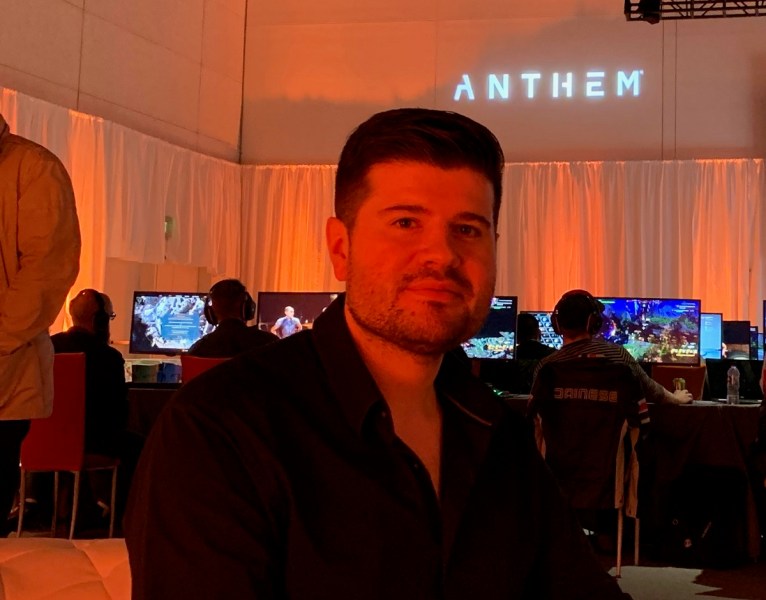
Above: Mike Gamble is the lead producer at BioWare on Anthem.
GamesBeat: What’s your role been on this project?
Mike Gamble: Lead producer. I’m responsible for working with the executive producer to make sure the vision of what Anthem is is expressed in the game. That filters through all the things we do. Ultimately I make sure that things get done. I was on Mass Effect, the trilogy and Andromeda, and then once Mass Effect was done, I moved over to Anthem.
GamesBeat: What were you thinking about at the beginning, what kind of game this would be? Especially compared to Mass Effect.
Gamble: We wanted something cooperative. We wanted something you could play with your friends. You could experience a great story with your friends in a cooperative environment, not a single-player environment. That was the inception. We wanted to make something very different from what we’d done before in terms of setting. It wasn’t high fantasy or high science fiction. We wanted to make a platform for us to continue to tell great stories for a long time. Those were the goals.
GamesBeat: What kind of BioWare DNA is still here? Is there still that emotional story?
Gamble: I think so. Hopefully, when you play it, you start to see some of the characters’ personalities poking through. Eventually, they grow on you and you like them more and you care about what happens to them. You care about the things you can prevent and the things you can’t prevent. You get engaged in this crew, in this world. You look forward to seeing what happens with them. That’s what we’re hoping.
GamesBeat: If we look at the map now, where we are, how much of the world are we seeing in these different sections?
Gamble: That’s the open world for the game. You’re seeing that. The world itself — what you don’t see on the map is the verticality and the things you can discover by going over and under, things like that. To navigate through the world, it actually takes quite a while, especially considering all the things you can find and collect and fight on the way.
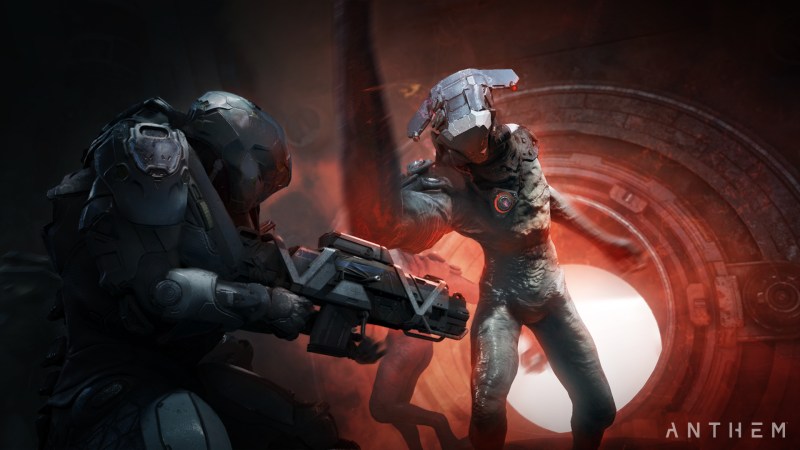
Above: Anthem’s trying to capture the BioWare rep for narrative.
GamesBeat: When I came back from the free play, it showed me a little map of where I was. It had little squiggly lines from where I’d just been flying around. Once I’m more used to it, how would I recognize things and not get lost so easily?
Gamble: Certain regions have certain markers, visual geometric markers, whether it’s a giant tower or a Scar encampment on the side of the mountain. There are visual markers.
GamesBeat: When a name comes up, is it telling you the mission, or where you are?
Gamble: That’s the location, the region. And of course there’s your map and you can see where you went. There’s a compass you can use to navigate around, east and west, north and south. Some of the things you can do are denoted by in-world objective markers and others aren’t. Collectibles and smaller things for you to find are secret. There might be a little VFX bubble around it and you can spot that. If you’re on a mission, it will lead you around.
GamesBeat: It’s not a very crowded HUD. Did you want that for a particular reason?
Gamble: Yeah, we wanted it to be pretty clean. There’s a fantasy to flying around and seeing the Javelin and the beautiful world. We didn’t want to have too much stuff in there. There’s a lot of it in your map, though, once you press the button and see it.
GamesBeat: How do you feel about where your buzz is, a month out? What are you hearing back?
Gamble: We feel pretty good, actually. One thing we’ve done differently on this game versus some other ones is we’ve been pretty transparent with what we’re doing. We’ve had live streams. We’ve talked to the press a lot. We’ve talked to the fans and influencers a lot. We’ve been open with the things that are in the game and the things that aren’t. We’re not lying about anything, certainly, but we’re not really holding any information back, either. I think the fans are liking that.
Launching a new IP is always this way. It’s easy to say, “Hey, have you seen the 14th sequel to whatever game?” You know what that is because you know the last 13. For a new IP, you have to build that knowledge from nothing. We’re happy with how people are enjoying it. We have a lot of good feedback from events like this, and alpha tests that people are not supposed to talk about, but they talk about anyway. [laughs] All that stuff.

Above: Fort Tarsis in Anthem.
GamesBeat: Going into this, are we supposed to already know what Anthem is about? Or is that part of the mystery?
Gamble: What you see in the game at the beginning, it’s a cold open into the world. It onboards you a little bit, but we want the world of Anthem to be a mystery. We want people to be able to explore and find out more and more about it. We’ve done five or six trailer-type things which paint the world, paint the story, give you the context you need to start playing, but then after that, you need to discover for yourself.
GamesBeat: This thing with a lot of lights at the center of it all, it’s just randomly spitting out creatures?
Gamble: The way it works, the world was created by these gods. It was actively pushed together through this force called the Anthem of Creation. That’s what we call it. They called it something completely different.
GamesBeat: It’s like their Unreal Engine.
Gamble: [Laughs] Yes, exactly! It’s like their Unity.
GamesBeat: So they left it there and all this stuff comes out?
Gamble: Well, the tools are there, and then they just disappeared. We don’t know where they went. They could have been taken away. They could have been killed. They could have chosen to disappear. But those tools are there, and those tools create chaos in the world. That chaos is what a lot of the gameplay ties back to.
GamesBeat: Since it’s a live game, how do you pave your own road there? It reminds me somewhat of where Destiny started, how they would introduce new chapters in new versions. In your vision of where this goes in the long term, what do you want this to be like?
Gamble: I want it to be like Anthem. Ultimately what that means is, a long-tailed game that has great characters and great storytelling at its core, with the superheroic fantasy of flying around. You can play by yourself if you want, but we don’t necessarily want you to. We want this to be a cooperative experience. We really do. The game shines the best when you and other players are playing together. It’s very different in its DNA from some of the other “looter shooters.” We want to lean into that.
GamesBeat: When you release an update, what kind of update would that be? A new campaign? A new chapter of story?
Gamble: It could a new chapter in the story. It could be a new mission, only a new mission. It doesn’t have to be a whole–you wait 19 months for a giant expansion. It can be, this week there’s a new mission, but also there’s a new repeatable thing for you to do, and also there’s a new piece of Javelin gear for you to collect. We can do that in small ways. We can continue to tell stories, and then we can also change the world.
The world state–once you go into free play, or even on the missions, that big world out there is controlled by us completely. Fort Tarsis is controlled by you. The choices that you make and the things you do, it will change based on that. But when you go out, that’s us.
GamesBeat: You could do a cataclysm, like in World of Warcraft.
Gamble: Exactly.
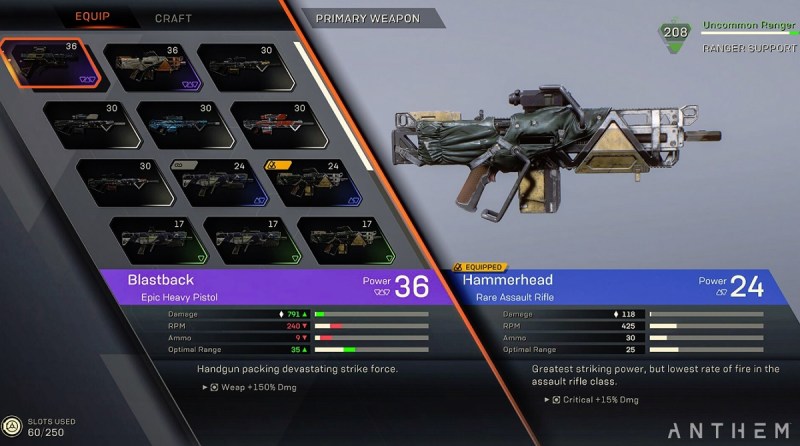
Above: Anthem’s customizable weapons.
GamesBeat: Is it a little like Tides of War in Battlefield, where a series of things will happen?
Gamble: Yes and no. We’re not talking a lot about the story progression post-launch yet. We’re going to launch first and then give people an idea of what they can expect in the future. We want to keep that fairly vague so we can surprise people. You can be playing, and then on Friday something might happen, or next Monday, or whatever. We want to keep people guessing a bit.
GamesBeat: Is that all scheduled at this point, though?
Gamble: Yep. We know what we want to do. To be totally honest, there’s a portion of the live team that says, “This is the plan. This is the thing we want to do once we launch the game.” They have a narrative arc that they want to tell. And then there’s another part of the team that says, “OK, depending on what the fans want and what everyone yells about, we can react to those things.” There’s both of those.
GamesBeat: If you go into something with just one character instead of four, does the number of enemies change, or the difficulty?
Gamble: Both. It’ll scale the numbers based on whether you’re one, two, three, or four players. It’ll scale the difficulty as well. Maybe fewer enemies will show up at a certain thing, and those enemies will be weaker. But ultimately it’s going to be really challenging if you want to play alone on the hardest difficulty. The game just isn’t balanced to make that a walk in the park. You can play on easy if you want, and you can probably play on normal, but we want to encourage players to group up and be friends.
GamesBeat: If you want to succeed solo at the very beginning in free play, is there a good idea for what you should do at the start? I saw something very big, and it didn’t seem like a good idea to take that on by myself.
Gamble: That’s a good reaction. Avoid the bait. Like in any other game, people will learn by dying. I knew I wasn’t ready to take on the Weapons in Final Fantasy until I knew I was ready. After that, I went in full bore. But the game will tell you “no” because it’ll keep on killing you. You’ll learn eventually.
There are things for you to do, obviously, as a solo player. Free play can be played very much as a solo experience because you can split up the squad. One person can be in the northeast, another person in the southwest, and it holds up all the same.
GamesBeat: Why can’t you fly for longer periods of time?
Gamble: That’s tied to the progression mechanics. It’s tied to your components and tied to your gear. There’s a progression element in it. But being able to fly literally forever–players would never go back to the ground. There’s a lot of stuff happening on the ground too.
GamesBeat: The weapons you start with, what happens to those over time?
Gamble: You can do a couple of things. Your Javelin is your primary vehicle for progression and customization. You can get components and gear, which change fundamental abilities like how many supers you have, or how long you can fly, or your cooldown rates and things like that. Then you can find new weapons — new shotguns, new assault rifles. This is the constant chase of the looter shooter style of game. Your weapon is only the best until you find a better one, and then you salvage it and scrap it and bring the new one in. Or you collect an arsenal of different types of weapons that you find along the way. That’s the primary progression model in the game.
GamesBeat: If I’m playing Colossus now, what am I experiencing and what am I potentially missing out on by not playing the other classes?
Gamble: It’s a playstyle, essentially. A good analog, obviously–the Colossus is the tank. People who play the Colossus usually like to play tanks. They like to do debuffs and buffs. They like to gather aggro while everyone else takes the enemies out. That’s a play style. You’re only missing out on a different play style. But even then, you can just go play the Storm. You’re not locked into a class for the whole game. You just switch whenever you want.

Above: Anthem’s Javelin exosuits will get you off the ground.
GamesBeat: The easy thing I found to do was the ground-pound. And then my colleagues could shoot stuff.
Gamble: Yep, that’s definitely a good move. Have you held your shield up? That’s the aggro move — the enemies will attack the Colossus, hopefully, everyone else attacks them.
GamesBeat: Is that on a timer?
Gamble: The shield isn’t. But you can do a shield bash, do the shield while you fly. You have a bunch of things you can do.
GamesBeat: Am I flying for a shorter time as the Colossus?
Gamble: No, that’s purely based on the gear you have. If you have a good gear piece as a Colossus and then put it on as a Storm, it would have the same effect.
GamesBeat: Right now there aren’t that many things to choose from in the main story. But is it going to be clear where the main story is if you want to stay on that track?
Gamble: It’s denoted differently in your journal. It’s called the Critical Path, something like that. You can track quests and untrack quests just like you can in many other games. You’ll gather a bunch of quests, and then you can choose which ones you want to track. Then it will lead you towards them. You should be about four missions you can choose from right now. One of those is the critical path that moves you forward. I believe usually the mains are yellow and the side missions are blue. But it’s tracked in a different thing inside your journal. When you open it up you’ll see — “These are agent missions, and these are the critical path.”
GamesBeat: The navigation when you’re flying and moving around–you know what general direction to go in, but you can’t very precisely guide people, I guess?
Gamble: Well, we don’t want to. You follow the breadcrumbs, but there are areas for you to diverge. We don’t want to breadcrumb the player every 15 meters around the map. Otherwise, they don’t get to explore anything.
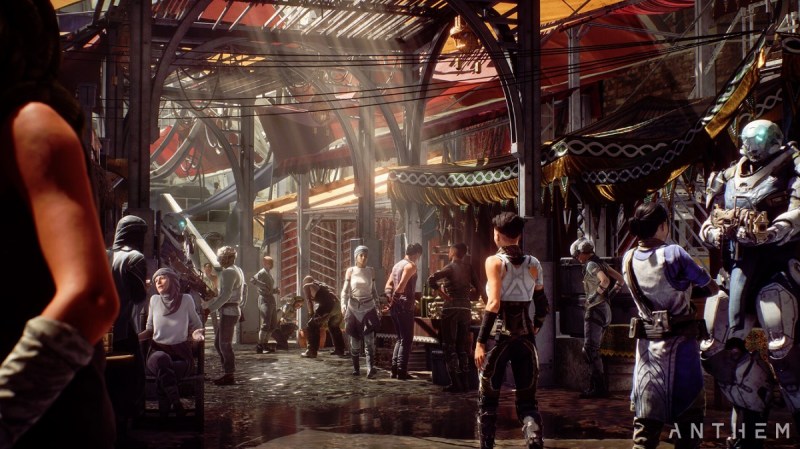
Above: Inside Fort Tarsis
GamesBeat: So it’s OK if you get lost?
Gamble: Yeah! Just open up your map and see where you’re going. But there should always be an objective marker in the map, in the world, which leads you toward the right direction, at least on the missions. In the free play we want you to play freely.
GamesBeat: How quickly are we going to run into what you might call the real villains here? What’s her name?
Gamble: The Monitor, yeah, and the Dominion. I don’t know if you’ve played Incursion yet.
GamesBeat: I’m in the middle of starting it.
Gamble: There you go. During that mission. That’s the second critical path mission. That’s maybe not chronological, but the way this works, you go into the game, go through the tutorials, and it goes wide. There’s a critical path that goes through all of that, and then all the other things you’ve been playing are side content, Agent stuff.
GamesBeat: Will we know what this is all about fairly quickly, then?
Gamble: Yeah, who the enemy is.
GamesBeat: What do you think about the outcome so far?
Gamble: I’m pretty excited about the buzz we’re building. The fact that it’s a new IP again–it takes time for people to get their hands on it. We want people to play the game. You can tell all you want, but it doesn’t actually do anything until people play it. That’s why we’re releasing a demo next week.
GamesBeat: How much alpha and beta testing has there been so far?
Gamble: There were a lot of closed, NDA’d events. There’s a build on servers that many people are playing. We haven’t done a public beta, but the demo is essentially–everyone will get to play it for the first time.
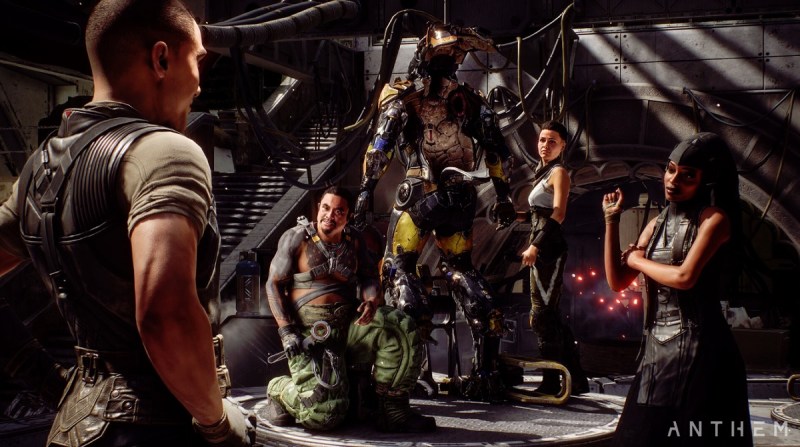
Above: Anthem’s Cyphers are part of your crew and a helpful lot.
GamesBeat: The games where people do a giant public beta and then launch many months later, that seems to be one way to produce a game. But you guys aren’t doing that. Do you have more confidence in where this is going?
Gamble: Yes and no. It’s just a strategic way of doing it. Once the game is out, it doesn’t matter if you’ve done a lot of beta testing or not. There are still issues, and we want to find the issues as quickly as possible. All that said, we’ve done a lot of these things. We just haven’t done a lot of public betas yet. We’ll find out stuff from the demo as well. We’re using that. It’s just a change of strategy. We are doing testing. We’re just not doing a public one that everyone can join up for.
Plus, we think the game is pretty solid. We’ll look out to see if issues come up over the next month and we’ll fix them as we get to them.
GamesBeat: Is this something like The Old Republic as far as how much time you’ve put in? Is it a game you’re going to be doing forever?
Gamble: I don’t know. It’s a big commitment. But there’s a team in Austin that’s going to basically take on the development and live service of the game after launch. There are others in Edmonton who will move on to different things. BioWare is now big enough that we can handle multiple games in development at once.
GamesBeat: Back to Star Wars?
Gamble: You never know. You never know.


